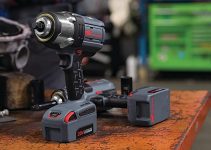
- Compatible with all ignition systems
- Works on both 6V and 12V vehicles
- Doubles as flashlight, which makes working in tight spaces easier
- Digital LED readout
- Super bright Xenon light
- Durable and robust ABS housing

- Ensures steady readings with no delays at all engine speeds
- Color-coded cables that are also heat-resistant
- Durable ABS housing with integrated light protection
If you work on cars a little, you already know that it’s the spark plugs’ job to light up the air/fuel mixture inside the combustion chambers. However, for the engine to run optimally, the spark doesn’t only need to happen—it needs to happen at the right time. And with technology improving rapidly in recent years, cars are now all equipped with variable valve timing systems. It’s now common for engines to also have a variable spark timing in an effort to provide the most power and the best fuel efficiency possible.
Whether you want to adjust the spark timing or simply check if it’s properly set, there’s no way around it, you’ll need a good timing light. This tool allows monitoring when each of the spark plugs ignites and to correct whatever needs to be corrected for optimum performance. Since they have such an essential task at hand, timing lights should be precise, reliable, and easy to use. However, like most other tools, there is a wide range of different models available on the market. To help you find the right model for you, we reviewed and curated a selection of some of the best timing lights out there.
You’ll see that we tried to select a little something for everyone. Some work better for older cars, some are better suited for beginners and some of them will really only be useful for full-fledged mechanics. Consequently, make sure to correctly evaluate your budget and needs before you start shopping. After all, no need to pay the big bucks for a techy model that you won’t really use.
Enjoy!
Table of Contents
Timing Light Reviews
1. Innova 3555 Advance Timing Light
[amazon fields=”B000EVYH7W” value=”thumb” image_size=”large” image_alt=”Innova 3555 Advance Timing Light”]
Innova is a manufacturer producing specialized tools and equipment for automotive enthusiasts and professional mechanics. The firm also has a range of timing lights in its lineup, with the 3555 model being the entry-level variant.
Still, with features and functions that allow tackling even the most demanding tasks, it is more than capable. It will enable users to diagnose a no spark condition, check the timing advance or retard and perform a skip circuitry test. The analog advance dial is very helpful when checking base timing and when advancing or retarding the ignition.
This device will easily fit into any engine bay, thanks to its slim barrel and compact shape. Besides, the grippy handle with a built-in protective guard ensures a safe and comfortable operation while using one arm only. Worth mentioning, the detachable cables can be replaced if damaged, which is a possibility when working around a running engine. The only real downside is that this test light relies on operator skill for accuracy due to its analog nature. If you are beginning in the field, keep reading—we’ve got easier models to use below.
Highlighted Features
- Slim barrel makes aiming at the timing mark easier
- Patented skip circuitry test, which tests up to 9,990 RPM.
- Advance dial makes checking base timing and advance or retard simpler
- Detachable leads ensure easy replacements and storage
Pros
- Overall shape is suitable for confined engine compartments
- Detachable cables
- Affordable price
Cons
- Accuracy demands some skills
2. Innova 5568 Pro Digital Timing Light
[amazon fields=”B000EVU8J8″ value=”thumb” image_size=”large” image_alt=”Innova 5568 Pro Digital Timing Light”]
The Innova 5568 timing light is an upgraded variant of the previous model, with whom it shares the overall design. With features like a compact shape and a wide range of diagnostic modes, it has all the upsides of its entry-level cousin.
However, despite the similar appearance, the 5568 is a far more powerful tool that aims at professionals. The most obvious difference is the LED display, which replaces the analog advance dial and gives several digital readouts. Some of the parameters it can display include engine speed, ignition advance in degrees, and voltage. This makes the ignition timing procedure more accurate and much faster, which might be a strong point for professional users.
Several other significant differences set this device apart, with the housing being one of them. While the entry-level model has a plastic housing, this one uses a durable ABS and polycarbonate blend. This improves resistance to mechanical damage and scratching, ensuring longevity and long-term reliability. The Innova 5568 also has detachable cables, but these are significantly longer, allow better flexibility and increase operational area. The only real downside is the price, which is slightly higher than some similar devices on the market—but quality always comes at a price, right?
Highlighted Features
- Digital LED display with four readouts
- Slim barrel makes aiming at the timing mark easier
- Patented skip circuitry test, which tests up to 9,990 RPM.
- Long detachable cables making storage and replacement easier
Pros
- Digital LED display ensures an accurate overview of ignition timing parameters
- Slim design is suitable for confined engine compartments
- Detachable cables
Cons
- Higher price
3. ESI 130 Self – Powered Timing Light
[amazon fields=”B00063WM1Q” value=”thumb” image_size=”large” image_alt=”ESI 130 Self – Powered Timing Light”]
At first glance, this ESI model may seem less elaborate than other timing lights on this list. However, a closer examination will reveal that looks may be deceiving, as it offers several unique features.
For starters, there is only one cable. Indeed, this timing light gets its power from two flashlight batteries. This makes work easier and faster, as there are fewer things to tangle inside the engine compartment. The compact design will also ensure access and unobstructed field of view in the most demanding applications.
Still, the biggest upside with this test light is the wide range of engines it can work with. Just like many other devices, it is compatible with all sorts of ignition systems, ranging from conventional to distributor-less ones. Besides, unlike other models that ensure precise reading up to around 10,000 RPM, this test light goes far higher. Depending on the ignition system, the ESI timing light will be accurate up to at least 14,000 RPM. Thus, it is ideal when adjusting ignition timing on smaller engines, such as in snowmobiles or scooters. The only real downside is that it offers a basic, analog interface.
Highlighted Features
- Accurate up to at least 14,000 RPM
- Compatible with all ignition systems
- Protection against high temperatures (up to 1200 °F)
- Several cable lengths available
- Bright flash at all speeds
Pros
- No battery cables
- Compact design
- Suitable for high-revving engines
- Affordable price
Cons
- No digital readouts
4. BOSCH FIX 7529 Digital Timing Light
[amazon fields=”B084DC45Z6″ value=”thumb” image_size=”large” image_alt=”BOSCH FIX 7529 Digital Timing Light”]
Bosch is one of the biggest names in the business, offering tools and equipment for a wide range of professions. A timing light from such a reputable manufacturer should be among the best models available, and the Fix 7529 certainly is. With features like microprocessor-controlled circuitry and a bright LED display, it’s ideal for experienced DIYers or professional mechanics.
Moreover, it can measure engine speed and timing advance, and can also set initial timing. Besides being compatible with all ignition systems, this test light also works on both 6V and 12V vehicles. A durable and robust ABS housing will ensure superb protection against mechanical damage and scratches.
However, the light itself is the feature that sets this device apart from the others on the list. While most timing lights use a standard halogen bulb, Bosch implemented a more powerful Xenon system. As a result, it generates a bright beam of light that shines up the area with timing marks, making it suitable to work in broad daylight, which is almost impossible when using a standard timing light. Although its price may seem high, Bosch’s timing light ensures excellent performance and dependable reliability.
Highlighted Features
- Compatible with all ignition systems
- Works on both 6V and 12V vehicles
- Doubles as flashlight, which makes working in tight spaces easier
- Digital LED readout
- Super bright Xenon light
- Durable and robust ABS housing
Pros
- Wide range of applications
- Xenon light makes working in daylight possible
- Digital LED display ensures an accurate overview of ignition timing parameters
Cons
- Higher price
5. MSD Ignition 8992 Timing Light
[amazon fields=”B003UNCXW2″ value=”thumb” image_size=”large” image_alt=”MSD Ignition 8992 Timing Light”]
If you are into tuning and racing as a whole, you already know MSD. It’s a popular brand among automotive professionals and enthusiasts, having a wide selection of user-friendly and advanced tools. Their timing light is an excellent example of a tool that does a great job meeting users’ demands.
For starters, a sturdy ABS housing with a protective lens over the light ensures adequate damage protection. Also, the color-coded cables won’t melt when touching hot engine parts, thanks to inductive metal pickups. As a result, this timing light will withstand real-life abuse with ease.
Furthermore, this timing light has a distinctive strong point, although it may not be that apparent at first glance. While other devices on this list are accurate, most of them have an inevitable delay in readouts at high engine speeds. Despite not being an issue for less demanding applications, this may lead to difficulties when tuning a high-performance engine. To solve this issue, MSD timing light offers exceptionally accurate and stable readings regardless of the engine speed. Hence, it is ideal for heavy-duty and performance applications, as it will ensure the engine lives up to its capabilities.
Highlighted Features
- Ensures steady readings with no delays at all engine speeds
- Color-coded cables that are also heat-resistant
- Durable ABS housing with integrated light protection
Pros
- Accurate at all RPM
- Easy to use
- Durable and resistant
Cons
- There is no digital display
What to Look for When Buying a Timing Light
Despite the differences in shape and configuration, all timing lights share the same purpose and an identical working principle. Mechanics and car enthusiasts use these stroboscopic devices to determine the exact crankshaft angle at which the ignition is happening.
Where to find the timing mark
When working with timing lights, you need to look for the timing mark. In most cases, you’ll find them on the harmonic balancer or camshafts pulley, as well as a fixed marks on the engine. If these marks line up when the timing light flashes, then the engine is firing at zero degrees.
How to choose the right tool
When choosing among any tools, it is essential to select one that is most suited for the type of job you regularly do, the frequency of those jobs, and your budget. Timing lights are no exception to this, with several key factors that future users should consider when buying.
The first thing to know is that ignition systems come in several variants, with each of them having its own set of pros and cons. A conventional ignition system has a single coil and a distributor that directs the power to the right wire. Many older cars use this simple setup, where mechanics have to adjust the ignition to occur at the right moment. This procedure requires a timing light, and all of them work well with this system.
However, most modern cars have a distributor-less ignition system (DIS), where the ECU triggers a spark for each cylinder. As a result of this automatization, in most cases, there is no need or possibility to adjust the ignition timing manually. Nonetheless, timing lights can help determine if the spark happens at the right moment when troubleshooting these engines. Still, not all lights are compatible with distributor-less systems, which is something to consider.
Size and power source
The timing light should be convenient and easy to use because of the limited space inside the engine compartment. These devices usually have several cables, with one attaching to the plug lead and the remaining two to the car battery. Managing all these cables around a working engine can sometimes be difficult, especially for less experienced users.
However, some timing lights have built-in batteries, eliminating the need for a pair of power cables. Another thing to consider is the shape and overall size, as bulky devices may be unsuitable for use in tight spaces. Additional features, such as illuminated displays and user-friendly interfaces, could help increase work efficiency. Lastly, not all timing lights offer the same level of preciseness, which can be an issue for more demanding applications.
Verdict
As we explained in this article, timing lights offer a wide range of features, despite the similar shape and appearance. Devices such as Innova 3555 and ESI 130 are an excellent choice for users who need a reliable and inexpensive tool.
Meanwhile, models like Bosch or Innova 5568 Pro may be a better option for more demanding applications. In the end, a timing light such as one from MSD will ensure superb performance regardless of engine speed. However, due to the higher price tag, they may be better suited for professional mechanics than trainees.








![Best Tire Changers for Amateurs and Professionals [2022 Review]](https://garagespot.com/wp-content/uploads/2022/01/Best-tire-changer-e1652905942544-compress-211x150.jpg)